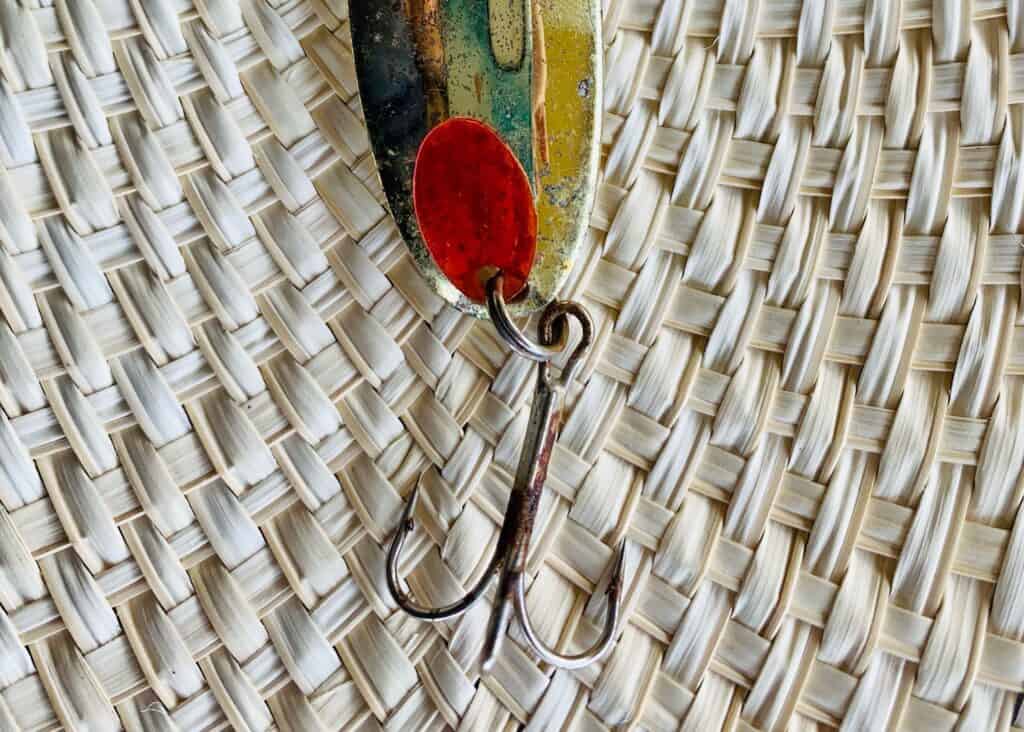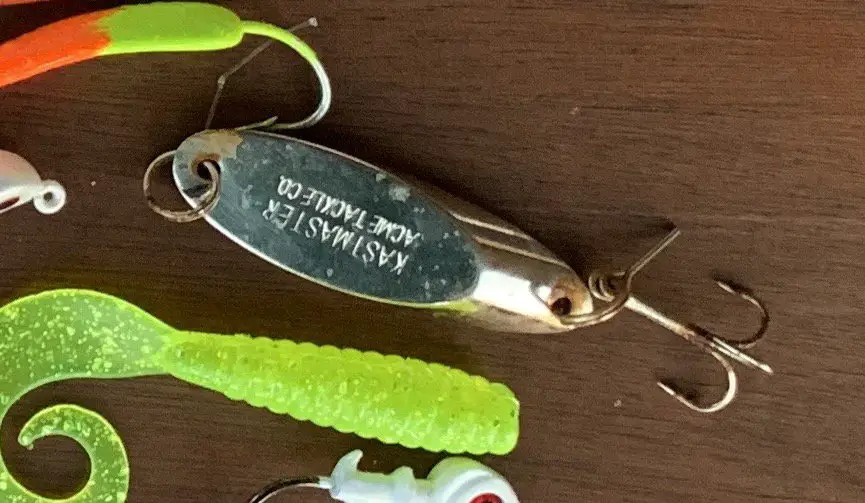A treble hook considered a “multiple hook” and is illegal on regulated and catch-and-release saltwater species in Florida when used in conjunction with live or dead natural bait. Many anglers choose not to use treble hooks with bait at all because you cannot be sure which species of fish will bite. You can still use treble hooks when attached to an artificial lure, though, because fish are unlikely to swallow an artificial lure. The rule exists to prevent a gut hook, and likely death from gut hook, on fish species the FWC is trying to protect.
Treble Hook Laws in Florida
Let's go ahead and talk about definitions so we're all on the same page. A “treble hook” is considered a “multiple hook” in the FWC laws. Specifically, “multiple hook” is defined as
(10) “Multiple hook” means a treble hook, two or more fishhooks bound together to comprise a single unit, or any hook with a single shank and eye and two or more pointed ends.
Reference: Paragraph 68B-4.002 Gear Definitions of the FWC
The expectation is for Florida anglers to always be aware of the laws surrounding their actions, so I encourage you to read the applicable laws before you target a specific species. Here is an example law regarding the use of treble hooks for Tarpon (a catch-and-release species in Florida):
“(2) Prohibited Gear and Methods of Harvest – A person may not harvest or attempt to harvest a tarpon within or without Florida Waters by spearing, snagging, or snatch hooking. A person may not use a multiple hook in conjunction with live or dead natural bait to harvest or attempt to harvest tarpon within or without Florida Waters.”
Reference: Paragraph 68B-32.006 Allowed and Prohibited Gear and Methods of Harvest of the FWC for Tarpon
The intent of the law is to prevent unnecessary death of a species the FWC is trying to protect. You will notice that this specific multiple hook law is found on regulated species (e.g. pompano or flounder) and catch-and-release species (e.g. tarpon or bonefish). This makes sense because fish are likely to swallow live and dead natural bait, and treble hooks are likely to result in a gut hook if swallowed (unlike circle hooks). If you were to combine live or dead natural bait with a treble hook and target a catch-and-release species, you would be increasing the likelihood of killing the very fish they are trying to protect.
Removing a Treble Hook
If you are targeting an unregulated species with a treble hook, you may accidentally hook a catch-and-release fish with a treble hook. You could hook the fish in the mouth, or a gut hook. You'll need to know how to remove the hook in either scenario. Removing a treble hook can actually be pretty tricky because of the multiple hooks.
If you hook the fish in the mouth, focus on removing one hook at a time. You'll need to grab the fish with a firm grip in the mouth and use needle nose pliers. You'll need to apply pressure away from the barb and then twist your hand to get it out. If you focus and do one hook at a time, you'll get it out in no time.
The answer is simpler if its a gut hook. Some beginner anglers may attempt to remove the hook because that's normally what you do when you throw back a fish, but you should be aware that trying to remove the hook from the gut will likely cause even more damage to the fish. Remember, when releasing a fish, you should be trying to maintain a good chance of its survival. Several studies have been done on the topic, and the best thing you can do is cut the line as close to the hook as possible, and put the fish back in the water head first. Fish are sometimes able to naturally lose the hook from their bodies, and sometimes able to live to a long time with the hook still in it. The head first throw back approach acts as a big breath of fresh air for the fish as it allows the water to flow across the gills in its natural way.
Benefits of a Treble Hook: How and Why You Would Use It
A treble hook can be an effective choice when targeting a fish species that typically doesn't turn right away when hooked, or a species that's known for putting up a fight. Statistically speaking, if the hook is in the mouth of a fish, there are three hooks working for you, versus just one if you were using a circle hook. That will obviously improve your chances of hooking a fish. However, if you consider the size of hook that will fit in a certain fish's mouth, the appropriate size circle hook will be larger in comparison to the treble hook that fits. Some anglers claim that treble hooks are less secure because their smaller size causes them to poke a part of the fish's mouth, but not completely puncture through it.
Multiple hooks on Artificial Lures
When I first started surf fishing, I was curious why treble hooks are commonly found on artificial lures when I knew there were laws about multiple hooks. When I read about it, it actually makes a lot of sense. The likelihood that a fish swallows an artificial lure is low, so it's unlikely to result in death by gut hook. Fish released back into the water after a gut hook are very unlikely to survive. If you're using an artificial lure with a treble hook, your actions are legal, as long as you don't put live or dead natural bait on it. Read more about artificial lures in our Surf Fishing Lures and our Best Bait for Surf Fishing articles.
Treble hooks are commonly found on artificial lures because they need the extra hooks to ensure a catch when the “bait” isn't being swallowed. Artificial lures will most often stay in and around the mouth of the fish, whereas single hooks, like J hooks and circle hooks with live or dead natural bait, are more commonly swallowed by the fish and then pulled back up into the mouth of the fish for a hook. In our J hooks YouTube video, we also talk about replacing a treble hook with an inline J hook on an artificial lure.

Alternatives to Treble Hooks
The most common hook used nowadays in surf fishing is definitely the circle hook. It is designed in such a way that it nearly always results in a mouth hook because the point of the hook points perpendicular to the hook shaft. Mouth hooks are what ethical and conservative anglers are after because it causes minimal harm to the fish, which decreases catch-and-release angling mortality. Circle hooks can be offset or non-offset, and sometimes the laws will dictate which you should use. For example, on the Atlantic Coast, any type of circle hook can be used on reef fish with natural bait, but the Gulf Coast requires non-offset, non stainless steel circle hooks on reef fish such as groupers and snappers.
“(3) Required gear in the Gulf reef fish fishery. Beginning June 1, 2008, for a person on board a vessel harvesting any of the species listed in subsection 68B-14.001(2), F.A.C., the vessel must possess on board and such person must use the gear specified in paragraphs (a) and (b).
(a) Non-stainless steel circle hooks. Non-stainless steel circle hooks are required to be used on hook and line gear when fishing with natural baits. “Circle hook” means a fishing hook designed and manufactured so that the point is not offset and is turned perpendicularly back to the shank to form a general circular or oval shape. Non-stainless steel J-hooks may be used instead of circle hooks when harvesting yellowtail snapper for commercial purposes with natural baits in the Gulf of Mexico south of Latitude 25°09’ North (consistent with the Federal Standard established in 50 C.F.R. §622.30(a) as of March 13, 2017).”
Reference: Paragraph 68B-14.005 Regulation and Prohibition of Certain Harvesting Gear: Allowable Gear, Incidental Bycatch, Violation of the FWC for Reef Fish
Some fishermen choose to go with J-hooks which are characterized by the point of the hook pointing parallel to the shaft. These are very easy to put bait on, but have the disadvantage of causing a lot of gut hooks. Another advantage of J hooks is ease of removal. The long shaft is something many anglers will grab onto to twist out of a fish's mouth. This is easy with a J hook, and much more challenging with a circle hook.
Kahle hooks are essentially a middle ground between circle hooks and J hooks. On Kahle hooks, the tip of the hook points at about a 30-45 degree angle with the shaft. They are known for being easier to bait than a circle hook, and causing fewer gut hooks than a J hook. If you'd like to read more about circle hooks vs kahle hooks, check out our article on it here.
Hope you enjoyed the article. Tight lines, y'all!
Recent Posts
Fat Cow Jig Strips: The Ultimate Bucktail Jig Upgrade for Surf Fishing
As discussed in my previous article, "Surf Fishing with Bucktail Jigs: Ultimate Guide for Beach Anglers," bucktail jigs are a staple in any surf angler's tackle box, offering a versatile way to catch...
In my previous article, "Surf Fishing with Bucktail Jigs: Ultimate Guide for Beach Anglers," I introduced you to the bucktail jig and discussed how versatile of a lure it is for catching a wide range...

